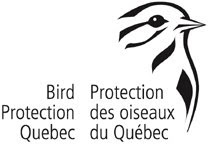Southwestern Quebec Early Solstice Field Trip
Wayne Grubert and I co-led the early solstice trip this morning covering 58 kms. from Rang de Trois south of Ormstown to Doullers archaeological site where we made the species count of what had been an excellent trip in great and varied habitat. The trip was early in two senses of the word as it began at 5:30 a.m. and also was a week before the summer solstice.
Number of participants: 12
Weather: a perfect June morning from 8 degrees C. to 22 degrees C. at noon when we stopped after 6 and a half hours of uninterrupted birding.
Bird of the Day: Unquestionably it was Golden-winged Warbler. There were at least 2 singing males on Biggar Road and eventually everyone in our group had scope views of this beautiful and much desired bird. It was a lifer for at least 3 participants. The only dissenting vote for Bird of the Day went to the female Ruffed Grouse who afforded good views as she stood for a few minutes on Gowan Rd near Massey. There were 3 chicks which, after their mother went into the forest, were left on the other side of the road. Even though they were tiny, they chose to fly across the road rather than walk it to safety.
Other highlights: Eastern Meadowlarks singing in many places; an Upland Sandpiper posing at length on a post on Gore Rd.; Scarlet Tanagers singing and showing well from the heights; Eastern Towhees singing duets with Golden-winged Warblers on Biggar; Pileated Woodpecker affording great flight views on Gore Rd; Eastern Bluebirds flying around their nest boxes at several places.
It was a splendid trip in excellent company . . thanks to Wayne as always for his great leadership (and the maps) and to everyone who shared in great birding in a wonderful area.
All the best for the summer season . . . over to you, Sheldon . . . Martin
Species List (73 species in all with the last being a Red-tailed Hawk seen by a few members of the group as they left Doullers)
Canada Goose 20; Mallard 15; Ruffed Grouse 4; Great Blue Heron 2; Turkey Vulture 2; Northern Harrier 1; Red-shouldered Hawk 2; Red-tailed Hawk 1; Accipiter sp. 1; American Kestrel 1; Killdeer 2; Upland Sandpiper 3; Wilson's Snipe 2; Ring-billed Gull 1; Rock Pigeon 12; Mourning Dove 15; Yellow-bellied Sapsucker 1; Downy Woodpecker 1; Northern Flicker 6;Pileated Woodpecker 1; Eastern Wood-Pewee 6; Alder Flycatcher 6; Willow Flycatcher 4; Least Flycatcher 3; Eastern Phoebe 6; Great Crested Flycatcher 3; Eastern Kingbird 4; Warbling Vireo 8; Red-eyed Vireo 20; Blue Jay 12; American Crow 12; Common Raven 1; Tree Swallow 20; Barn Swallow 12; Black-capped Chickadee 5; White-breasted Nuthatch 2; House Wren 6; Winter Wren 2; Eastern Bluebird 6; Veery 12; Wood Thrush 2; American Robin 20; Gray Catbird 6; Brown Thrasher 3; European Starling 50; Cedar Waxwing 30; Golden-winged Warbler 2; Yellow Warbler 12; Chestnut-sided Warbler 6; Black-throated Green Warbler 2; Black-and-White Warbler 4; American Redstart 10; Ovenbird 18; Common Yellowthroat 20; Scarlet Tanager 3; Eastern Towhee 2; Chipping Sparrow 15; Field Sparrow 3; Savannah Sparrow 6; Song Sparrow 12; Swamp Sparrow 5; White-throated Sparrow; 6; Northern Cardinal 1; Rose-breasted Grosbeak 6; Indigo Bunting 1; Bobolink 30; Red-winged Blackbird 40; Eastern Meadowlark 20; Common Grackle 30; Brown-headed Cowbird 5; Baltimore Oriole 6; American Goldfinch 10; House Sparrow 20
Bernache du Canada 20; Canard colvert 15; Gélinotte huppée 4; Grand héron 2; Urubu à tête rouge 2; Busard Saint-Martin 1, Buse à épaulettes 2; Buse à queue rousse 1; Accipiter sp. 1; Crécerelle d'Amérique 1; Pluvier kildir 2; Maubèche des champs 3; Bécassine de Wilson 2; Goéland à bec cerclé 1; Pigeon biset 12; Tourterelle triste 15; Pic maculé 1; Pic mineur 1; Pic flamboyant 6; Grand Pic 1; Pioui de l'Est 6; Moucherolle des aulnes 6; Moucherolle des saules 4; Moucherolle tchébec 3; Moucherolle phébi 6; Tyran huppé 3; Tyran tritri 4; Viréo mélodieux 8; Viréo aux yeux rouges 20; Geai bleu 12; Corneille d'Amérique 12; Grand Corbeau 1; Hirondelle bicolore 20; Hirondelle rustique 12; Mésange à tête noire 5; Sittelle à poitrine blanche 2; Troglodyte familier 6; Troglodyte mignon 2; Merlebleu de l'Est 6; Grive fauve 12; Grive des bois 2; Merle d'Amérique 20; Moqueur chat 6; Brown Moqueur 3; Étourneau sansonnet 50; Jaseur d'Amérique 30; Paruline à ailes dorées 2; Paruline jaune 12; Paruline à flancs marron 6; Paruline à gorge noire 2; Paruline noir et blanc 4; Paruline flamboyante 10; Paruline couronnée 18; Paruline masquée 20; Tangara écarlate 3; Tohi à flancs roux 2; Bruant familier 15; Bruant des champs 3; Bruant des prés 6; Bruant chanteur 12; Bruant des marais 5; Bruant à gorge blanche, 6, Cardinal rouge 1; Cardinal à poitrine rose 6; Passerin indigo 1; Goglu des prés 30; Carouge à épaulettes 40; Sturnelle des prés 20; Quiscale bronzé 30; Vacher à tête brune 5; Oriole de Baltimore 6; Chardonneret jaune 10; Moineau domestique 20
Sunday, June 16, 2013
Subscribe to:
Post Comments (Atom)





No comments:
Post a Comment